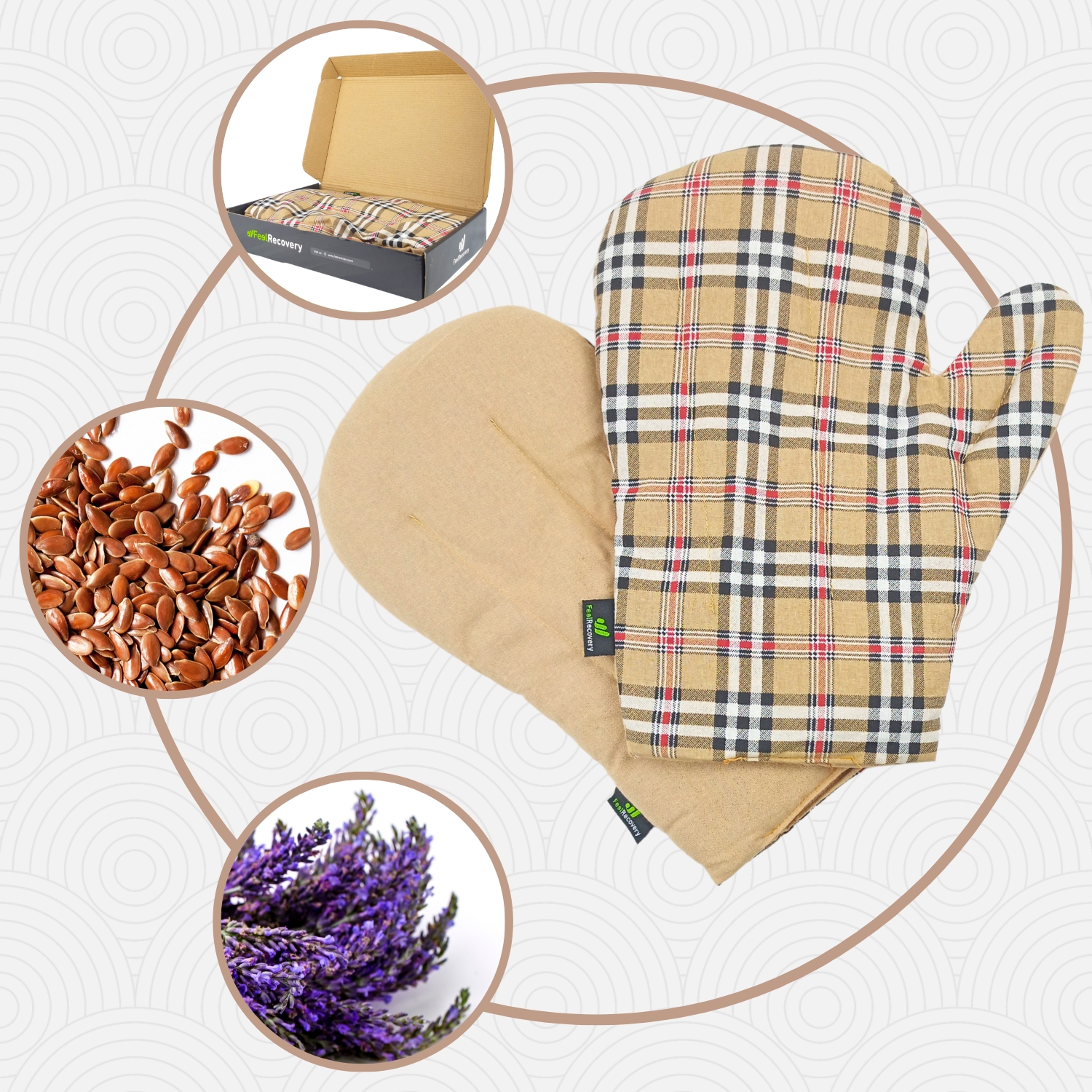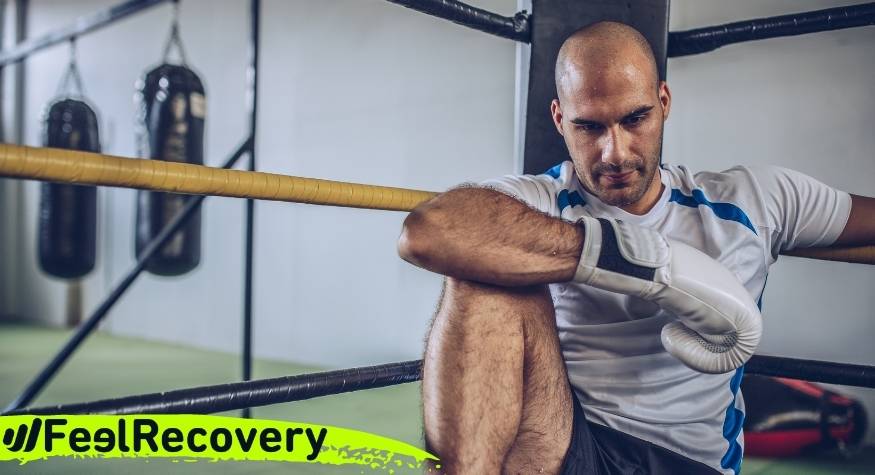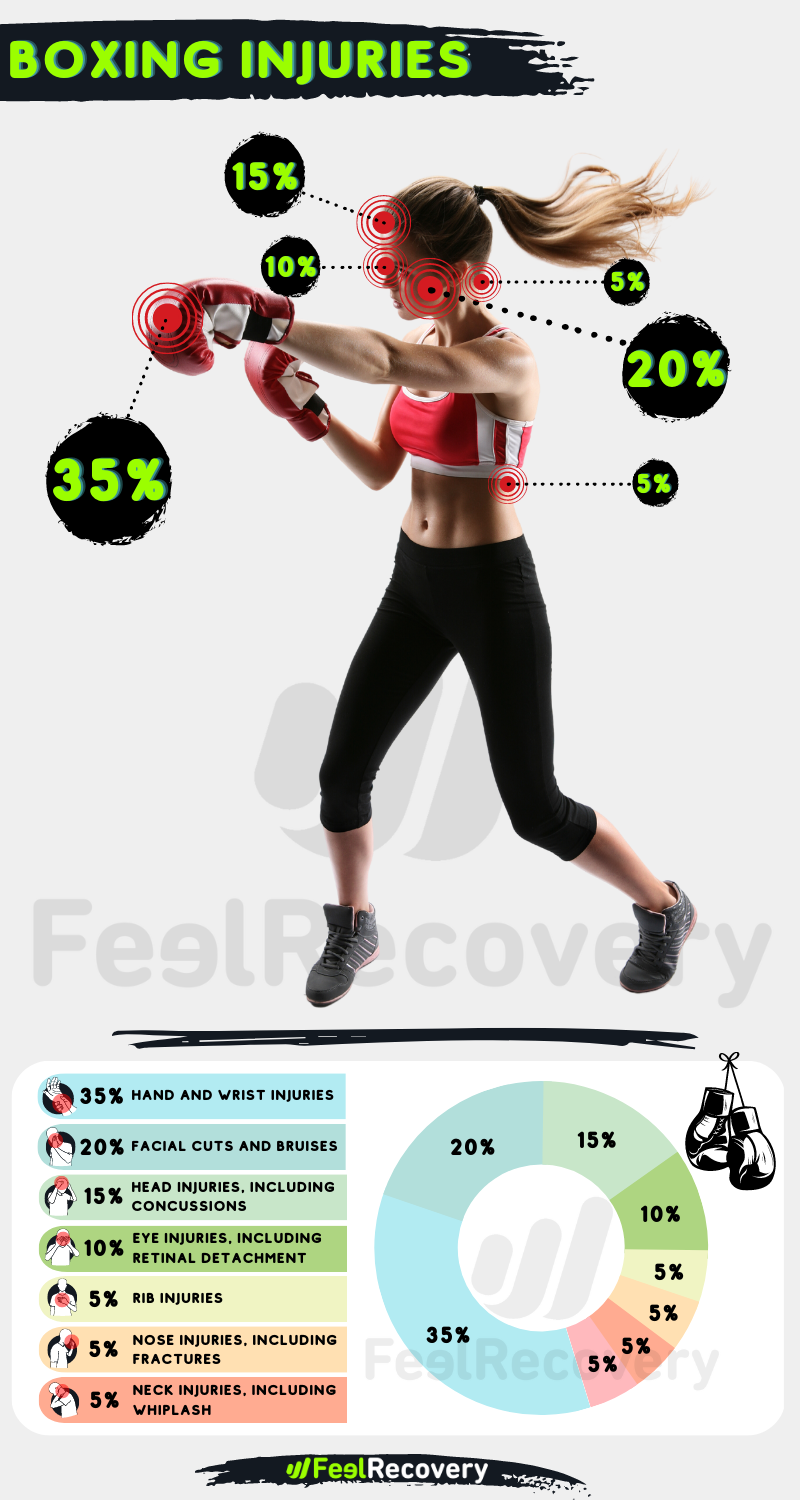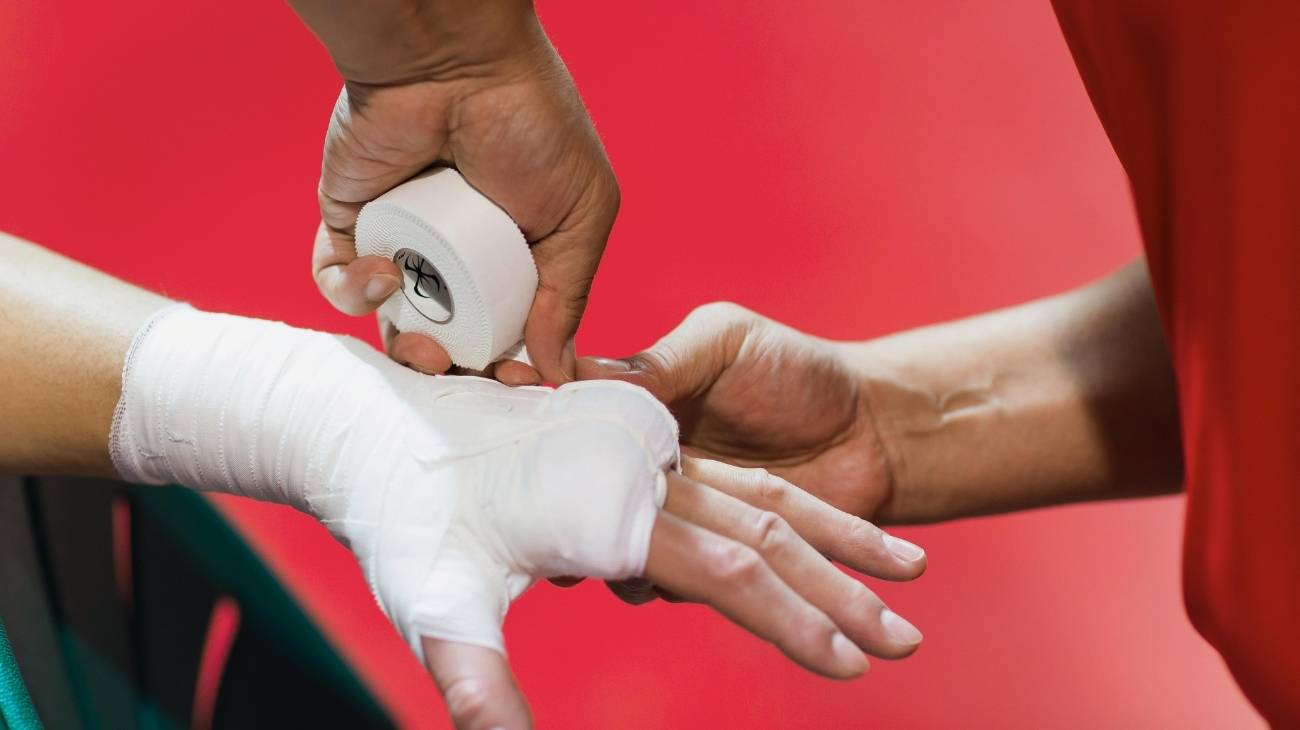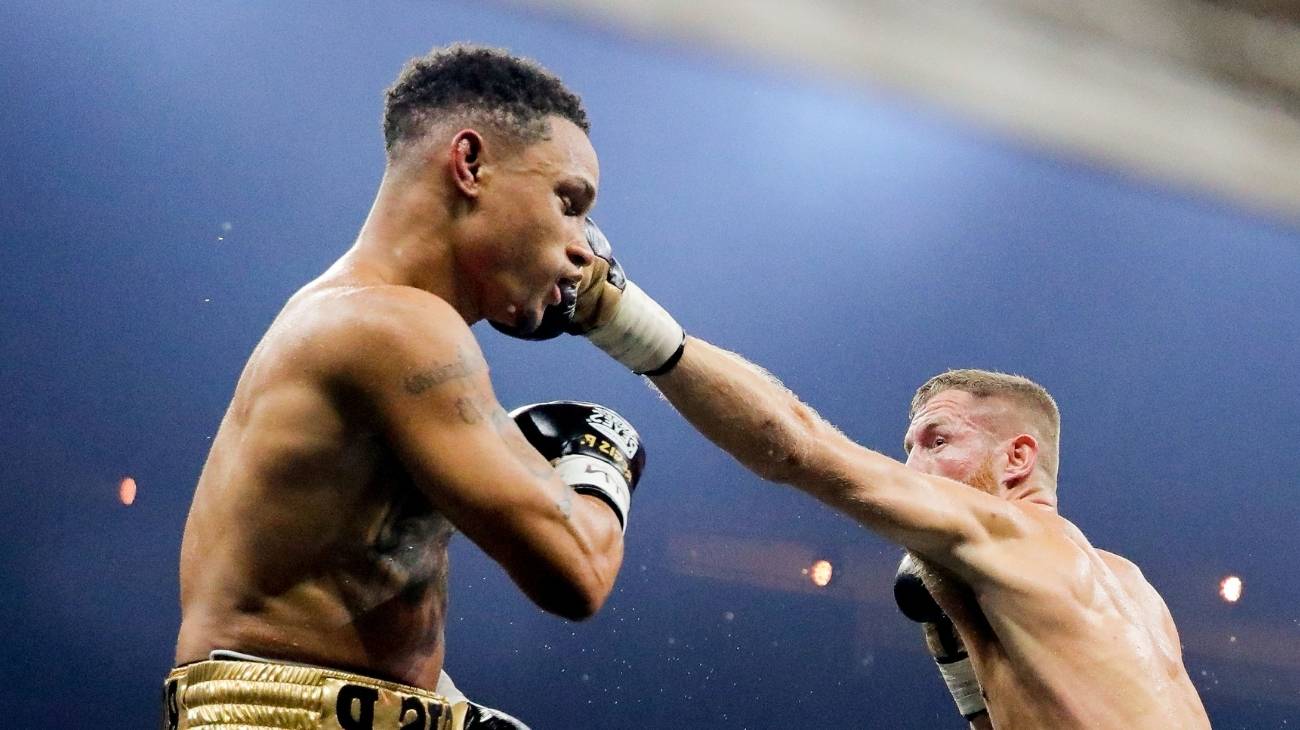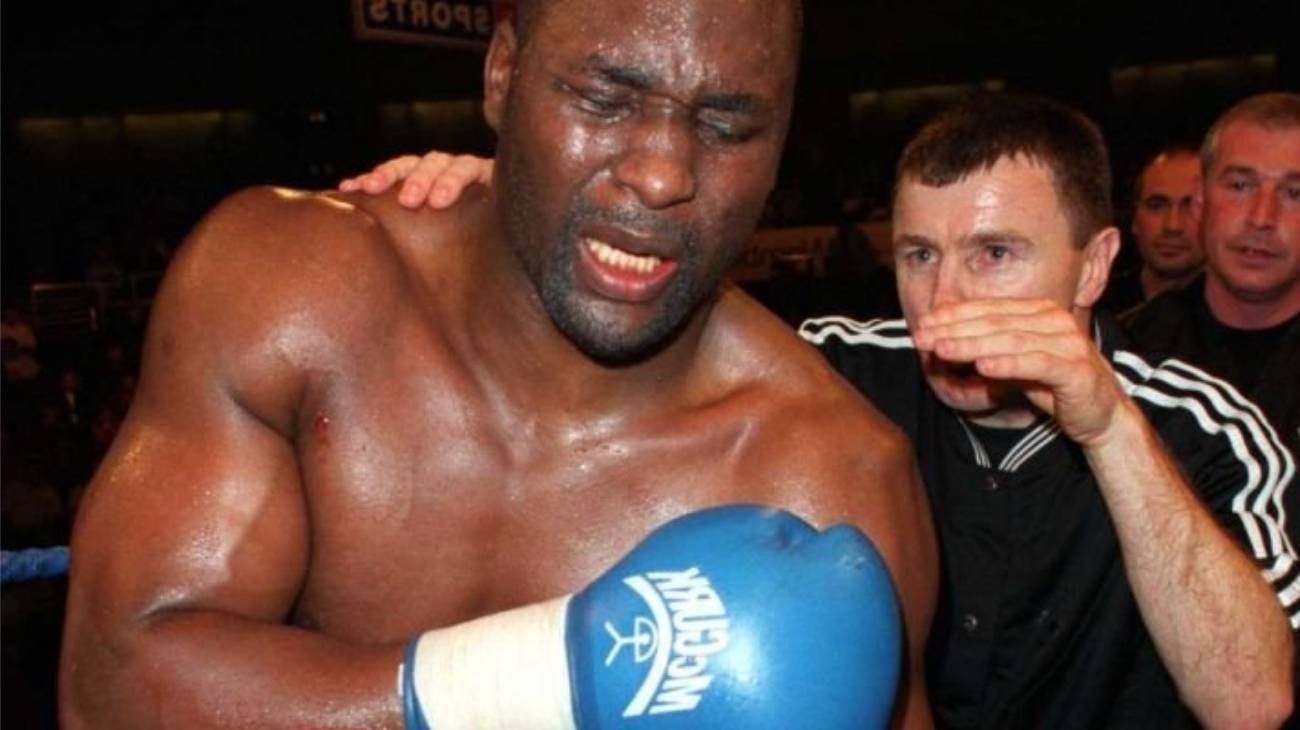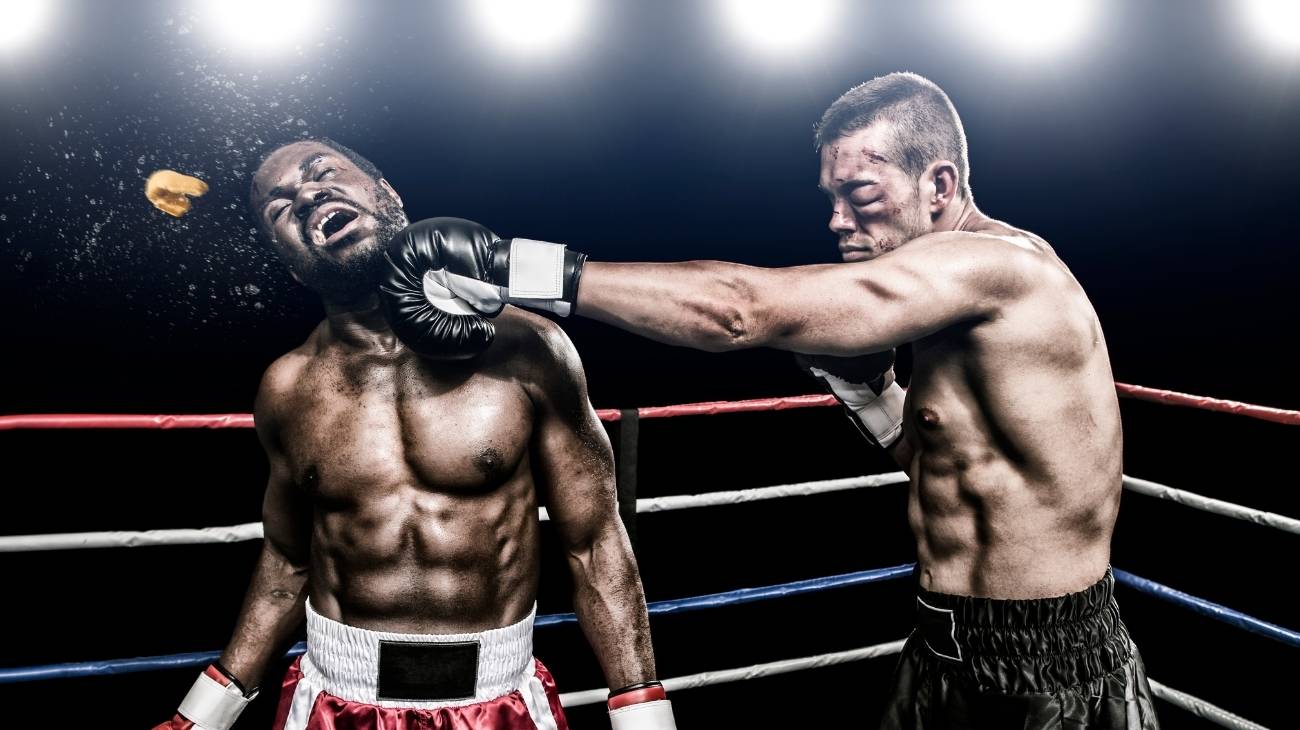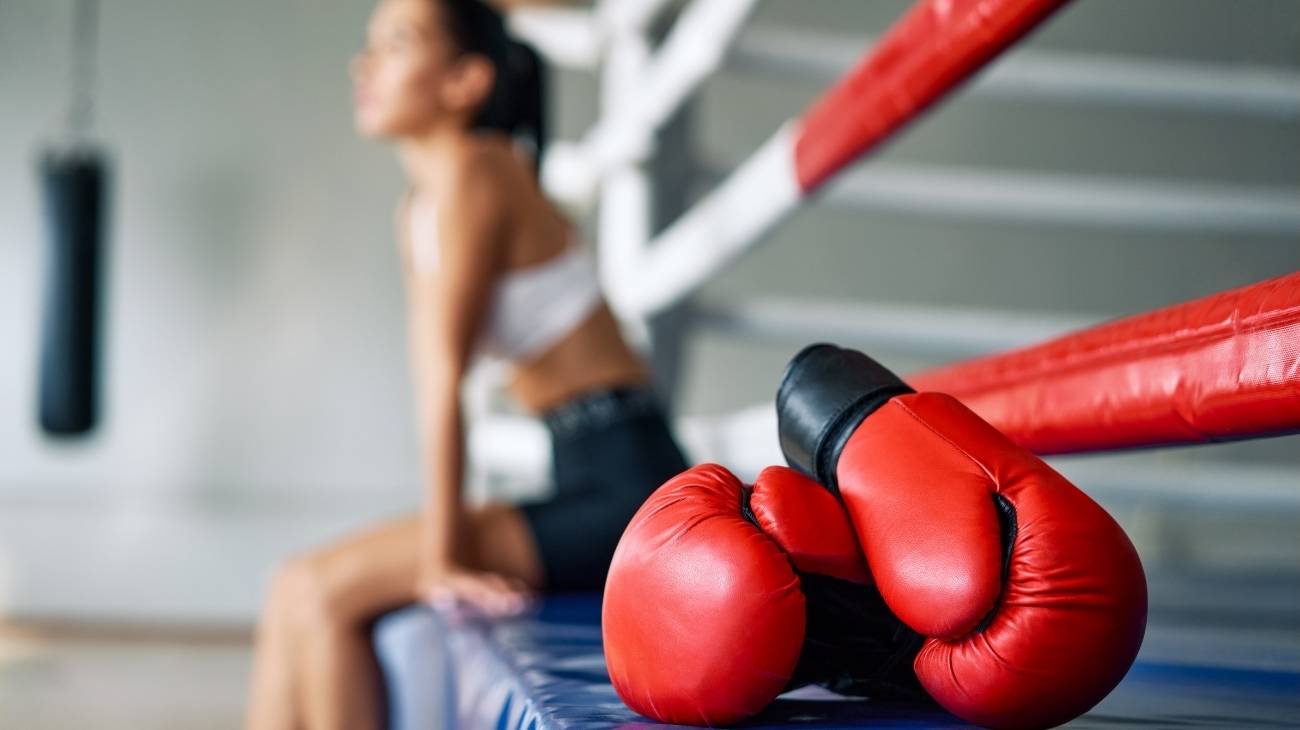The word "boxing" was already used in the 16th century to refer to a fight or a "fist fight" but it was in 1681 that a "boxing match" was considered a sporting contest. However, it was not until 1867 that the 8th Marquess of Queensberry, in conjunction with John Graham Chambers, created the rules of modern boxing, wanting to turn what was a brutal and bloody contest into something that today we can call "sport" and that many others call "art".
Like all contact sports, it represents risks to the physical integrity and health of its practitioners, both when receiving blows and when hitting the opponent. Contusions, muscle tears, fractures, sprains and bruises are some of the many injuries that boxing athletes can suffer. Here we will show you what are the most common boxing injuries and what measures can be taken to prevent and treat them.
What are the most common types of injuries in boxing and contact sports?
Boxing is one of the most physically demanding sports in existence today, so there are some risks involved. These risks range from the great physical aptitude that is needed to be able to participate in a fight, as well as the direct physical contact inherent to the sport and the nutrition and hydration that the athlete must take to the limit at the time of having a competition. All these elements form the perfect equation to put the physical health of the athlete at numerous risks and various injuries.
Prioritising the most common and the most harmful injuries for boxers, we can organise them as follows:
Neck, head and face injuries
Injuries to this part of the body are the most common and dangerous, as the face is the area that receives the most blows in a fight, despite being the one that athletes usually take the most care of.
- Concussion: When blows to the head and face occur, it is common for the brain to jolt from side to side after impact, these jolts can cause what is called concussion. This traumatic brain injury is often accompanied by headache, amnesia, confusion, nausea and even loss of consciousness, causing temporary cognitive symptoms due to the temporary deformation of the brain.
- Eye injuries: Boxing is one of the sports with the highest incidence of eye injuries in the world. One of the most serious injuries that a boxer can have is a severe eye trauma because this usually results in retinal detachment. Because of this, symptoms such as ocular scotomas, blurred vision, pain and eye inflammation occur.
- Post-traumatic cervical syndrome: When a rival blow generates an energy transfer in the neck, what is known as PTS or post-traumatic cervical syndrome can occur, resulting in consequences such as bone injuries or cervical sprains. These traumas result in clinical symptoms of pain, stiffness, tenderness, decreased movement, and neurological symptoms such as decreased reflexes and sensory deficits may occur.
Shoulder injuries
The shoulders are one of the joints that boxers use the most, so injuries due to wear and tear or severe impacts are more common than you might think.
- Rotator cuff injury: Whether during training or competition, the repetitive blows that the boxer executes generate a repetitive impact on the shoulder, its muscles, ligaments and tendons. These impacts can cause damage to the rotator cuff, which can range from tendonitis to tearing of the ligaments that support these muscles.
- Dislocations: When the humerus moves out of position, a dislocation occurs, which can be mild or severe depending on how far the bone is dislocated. These injuries are a problem if they occur in combat because they almost always cause damage to the ligaments and limit the mobility of the entire joint, which in turn conditions the fighter's performance too much.
Hand and wrist injuries
The hands are the boxer's weapon and can deliver punches that exert several hundred kilos of power on impact. If they are not well prepared for such demands, it is normal to suffer various injuries to them.
- Fracture or fissure of the 4th or 5th metacarpal: Also called the "boxer's fracture" because, to this day, it continues to be the most frequent injury in boxing. It basically occurs due to poor punching technique, as it happens when there is an erroneous deviation of the wrist and the closed fist is incorrectly positioned, receiving the impact of the blow on the 4th and 5th metacarpal (which are more fragile) and not the 1st and 2nd (which are relatively thicker and more stable).
Best products for boxing injury recovery
Bestseller
-
2 Ankle Compression Sleeve (Black/Gray)
$19.95 -
2 Ankle Compression Sleeve (Green/Navy)
$19.95 -
2 Ankle Compression Sleeve (Pink/Bordeaux)
$19.95 -
2 Knee Compression Sleeve (Black/Gray)
$19.95 -
2 Knee Compression Sleeve (Green/Navy)
$19.95 -
2 Knee Compression Sleeve (Pink/Bordeaux)
$19.95 -
2 Patella Knee Strap (Black/Gray)
$14.95 -
2 Patella Knee Strap (Green/Navy)
$14.95 -
2 Patella Knee Strap (Pink/Bordeaux)
$14.95 -
2 Thigh Compression Sleeve (Black/Gray)
$19.95 -
2 Thigh Compression Sleeve (Green/Navy)
$19.95 -
2 Thigh Compression Sleeve (Pink/Bordeaux)
$19.95 -
Acupressure Mat and Pillow (Black/Gray)
$49.95 -
Acupressure Mat and Pillow (Green/Navy)
$49.95 -
Acupressure Mat and Pillow (Pink/Bordeaux)
$49.95 -
Acupressure Pillow (Black/Gray)
$29.46 -
Acupressure Pillow (Green/Navy)
$29.46 -
Acupressure Pillow (Pink/Bordeaux)
$29.46 -
Back Support Belt (Black)
$34.95 -
Back Support Belt (Green)
$34.95 -
Back Support Belt (Pink)
$34.95 -
Foot Massage Roller for Plantar Fasciitis (Black)
$19.95 -
Foot Massage Roller for Plantar Fasciitis (Green)
$19.95 -
Foot Massage Roller for Plantar Fasciitis (Pink)
$19.95 -
Gel Eye Mask for Puffy Eyes (Gold/Black)
$11.95 -
Gel Eye Mask for Puffy Eyes (Orange/Pink)
$11.95 -
Gel Eye Mask for Puffy Eyes (Purple/Turquoise)
$11.95 -
High Density Foam Roller for Muscle (Black/Gray)
$29.95 -
High Density Foam Roller for Muscle (Green/Navy)
$29.95 -
High Density Foam Roller for Muscle (Pink/Bordeaux)
$29.95 -
Ice Massage Roller Ball (Black)
$39.95 -
Ice Massage Roller Ball (Green)
$39.95 -
Ice Massage Roller Ball (Pink)
$39.95 -
Microwave Arthritis Gloves (2 Mittens) (Hearts)
$29.95 -
Microwave Arthritis Gloves (2 Mittens) (Oxford)
$29.95 -
Microwave Heating Pad for Neck & Shoulder Pain Relief (Hearts)
$24.95 -
Microwave Heating Pad for Neck & Shoulder Pain Relief (Oxford)
$24.95 -
Microwave Heating Pad for Neck & Shoulder Pain Relief (Sport)
$24.95 -
Microwave Heating Pad for Neck Pain Relief (Hearts)
$19.95 -
Microwave Heating Pad for Neck Pain Relief (Oxford)
$19.95 -
Microwave Heating Pad for Neck Pain Relief (Sport)
$19.95 -
Pack 2 In 1 Foam Roller High + Soft Density (Black/Gray)
$29.95 -
Pack 2 In 1 Foam Roller High + Soft Density (Green/Navy)
$29.95 -
Pack 2 In 1 Foam Roller High + Soft Density (Pink/Bordeaux)
$29.95 -
Shoulder Support Brace (Black)
$24.95 -
Shoulder Support Brace (Green)
$24.95 -
Shoulder Support Brace (Pink)
$24.95 -
Soft Density Foam Roller for Recovery (Black)
$29.95 -
Soft Density Foam Roller for Recovery (Green)
$29.95 -
Soft Density Foam Roller for Recovery (Pink)
$29.95 -
Trigger Point Massage Stick (Black)
$14.95 -
Trigger Point Massage Stick (Green)
$14.95 -
Trigger Point Massage Stick (Pink)
$14.95 -
Wrist Brace (Black/Gray)
$19.95 -
Wrist Brace (Green/Navy)
$19.95 -
Wrist Brace (Pink/Bordeaux)
$19.95
How can injuries be prevented when boxing?
It is necessary for the boxer to develop various skills that allow him to respond correctly in a fight, this is acquired through continuous training and various recovery techniques. In the same way, the use of a proper technique can turn this sport from a dangerous practice into a harmless activity.
It is important for boxers to know how and when to execute a punch so that it has the expected effect and not to hurt themselves when delivering it. It is also important to learn how to take the blows and how to cover from them. All sports have their techniques to prevent injuries, however, each technique is different according to the sport.
Among the proper practices that every boxer should execute, we can point out:
- Warming up well: This step is essential to avoid injuries caused by poor execution of a blow or by receiving blows, as the previous warm-up will prepare the muscles for the activity, both to avoid injury and to have better dexterity. As with any good warm-up, it should begin gently, generally in boxing we start by jogging for 30 to 60 minutes, and then move on to a more intense workout that begins with running and sprinting, as this activity provides endurance and greater speed to the legs. This is followed by activities such as jumping rope, steps or climbing stairs at high speed, abdominal crunches and training with the punching bag.
- Finish your workouts with a cool-down: The cool-down is as fundamental as the warm-up, as it will help your breathing and heart rate recover their resting levels, help to avoid fainting and dizziness, eliminate the lactic acid accumulated in your muscles from the intense workout and prepare your muscles for the next workout. Activities to cool down include stretching, slow jogging, walking or continuing the exercise you were doing, but gradually decreasing its intensity.
- Good nutrition and hydration: In boxing the athlete's nutrition and hydration is pushed to the limit to fit into an appropriate weight category, either by increasing or decreasing it. According to the American Boxing Confederation (AMBC) a boxer should consume between 4000 and 6000 Kcal/day or between 65 to 75 Kcal/weight, with a macronutrient distribution of 50% carbohydrates, 15-18% protein (2-5g per kg of weight) and 30% fat, all based on the athlete's BMI.
- Improve your physical condition: Both anaerobic and aerobic exercises are very important in the training of a boxer, as these will allow the boxer to have all his energy available throughout the fight, that is, to know how to manage it during the development of the competition, either to recover or to respond with explosiveness when required.
- Sports massage: It is one of the most important parts of a boxer's training and recovery because it is a means through which the athlete is helped to improve his muscular performance, prevent injuries, find injuries and increase his capacity in the ring. It is executed through a set of manoeuvres to prepare the tissues, both for control between training sessions and for post-competition treatment.
- Use of heat and cold therapies: These are physical therapies that are used to improve the body's regeneration processes and help the homeostasis of the organism. Both cold and heat have their moments to be used, athletes usually use creams with cold and heat effects and each one comes with implicit indications for use according to what is required.
- Use of compression garments: These are a type of sports garment attached to the body that presses the boxer's muscles to promote blood circulation during training or competitions. They are very important because they will reduce post-exercise pain, contributing to muscle recovery due to the fact that having the muscles pressed and warm reduces the effects of delayed muscle fatigue.
- Use of acupressure therapies: Acupressure is a type of massage where the fingers are mainly used to apply pressure to specific points on the body. It is a massage technique from traditional Chinese medicine where the aim is to manipulate the boxer's energy flow at specific points on his body where the "chi" may be stuck or blocked.
- Use of thermotherapy and cryotherapy: Are therapies that reduce injuries caused by intense exercise, both are used at specific times. Cryotherapy uses cold to reduce inflammation, decrease blood flow to the muscles, improve muscle metabolism and act as an analgesic and antispasmodic, for which ice packs, cold hydrotherapy, cold compresses, among others, are used. Thermotherapy, heat is used as a resource for tissue restoration and oxygenation, that is to say, it helps the tissue repair processes, at the same time increasing lymphatic drainage and having antispasmodic and analgesic effects. For thermotherapy, water bags or hot stones, gel packs or thermal blankets can be used.
- Use of the right equipment: The right equipment is one of the most important things in boxing, because without it there is neither good technique nor protection. Complete boxing equipment includes: hand wraps, boxing gloves, boxing mitts, punching ball, punching bag, boxing rope, helmet, boxing trousers and boxing shoes that are approved.
How to apply the RICE therapy to treat first aid injuries in boxing?
The RICE therapy is a series of first aid actions to be performed when an injury occurs. The PRICE therapy is an update of the RICE therapy, but the latter is better known.
- Protection: Equipment such as splints or immobilisers are used to reduce the range of motion of the area where the injury occurred. This is most suitable for acute injuries as it avoids both pain and further damage to the injury.
- Rest: The most important thing for complete recovery from an injury, whatever the area of the body, is rest, either bed rest or the use of implements such as wrist braces, ankle braces, crutches, wheelchairs or cervical immobilisers, so that the person makes the minimum effort in the affected area.
- Ice: The application of ice will reduce not only the pain but also the swelling. Even so, cryotherapy should be evaluated by a specialist as it can affect the boxer's proprioception and cause further injury.
- Compression: Compression of the affected area is performed to avoid excessive oedema, as too much swelling leads to increased pain, decreased blood supply and functional decline. Elastic bandages are generally applied that do not squeeze the area, but keep it contained.
- Elevation: Elevation of the limb promotes venous return to the area, thus preventing oedema formation and even reducing pain.
References
- Zazryn, T. R., McCrory, P. R., & Cameron, P. A. (2008). Neurologic injuries in boxing and other combat sports. Neurologic clinics, 26(1), 257-270. https://www.sciencedirect.com/science/article/abs/pii/S0733861907001272
- Ross, R. J., Casson, I. R., Siegel, O., & Cole, M. (1987). Boxing injuries: neurologic, radiologic, and neuropsychologic evaluation. Clinics in sports medicine, 6(1), 41-51. https://www.sciencedirect.com/science/article/abs/pii/S0278591920310577
- Bledsoe, G. H., Li, G., & Levy, F. (2005). Injury risk in professional boxing. Southern medical journal, 98(10), 994-999. https://www.researchgate.net/profile/Guohua-Li-7/publication/7472412_Injury_Risk_in_Professional_Boxing/links/59a44bafa6fdcc773a373b70/Injury-Risk-in-Professional-Boxing.pdf
- Loosemore, M., Lightfoot, J., & Beardsley, C. (2015). Boxing injuries by anatomical location: a systematic review. Medicina Sportiva: Journal of Romanian Sports Medicine Society, 11(3), 2583. https://medicinasportiva.ro/SRoMS/RMS/43/boxing-injuries-anatomical-location-review.pdf
- Jordan, B. D. (1987). Neurologic aspects of boxing. Archives of neurology, 44(4), 453-459. https://jamanetwork.com/journals/jamaneurology/article-abstract/586343
- Loosemore, M., Lightfoot, J., Palmer-Green, D., Gatt, I., Bilzon, J., & Beardsley, C. (2015). Boxing injury epidemiology in the Great Britain team: a 5-year surveillance study of medically diagnosed injury incidence and outcome. British journal of sports medicine, 49(17), 1100-1107. https://bjsm.bmj.com/content/49/17/1100.short
- Gartland, S., Malik, M. H. A., & Lovell, M. E. (2001). Injury and injury rates in Muay Thai kick boxing. British journal of sports medicine, 35(5), 308-313. https://bjsm.bmj.com/content/35/5/308.abstract
- Gissane, C., White, J., Kerr, K., & Jennings, D. (2001). An operational model to investigate contact sports injuries. Medicine and Science in Sports and Exercise, 33(12), 1999-2003. https://europepmc.org/article/med/11740290
- Tjønndal, A., Haudenhuyse, R., de Geus, B., & Buyse, L. (2022). Concussions, cuts and cracked bones: a systematic literature review on protective headgear and head injury prevention in Olympic boxing. European journal of sport science, 22(3), 447-459. https://www.tandfonline.com/doi/full/10.1080/17461391.2021.1872711
- Jayarao, M., Chin, L. S., & Cantu, R. C. (2010). Boxing-related head injuries. The Physician and Sportsmedicine, 38(3), 18-26. https://www.tandfonline.com/doi/abs/10.3810/psm.2010.10.1804




















































